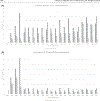National experience with living donor liver transplantation for hepatocellular carcinoma
- PMID: 35226793
- PMCID: PMC10266543
- DOI: 10.1002/lt.26439
National experience with living donor liver transplantation for hepatocellular carcinoma
Abstract
Living donor liver transplantation (LDLT) is an attractive option to decrease waitlist dropout, particularly for patients with hepatocellular carcinoma (HCC) who face lengthening waiting times. Using the United Network for Organ Sharing (UNOS) national database, trends in LDLT utilization for patients with HCC were evaluated, and post-LT outcomes for LDLT versus deceased donor liver transplantation (DDLT) were compared. From 1998 to 2018, LT was performed in 20,161 patients with HCC including 726 (3.6%) who received LDLT. The highest LDLT utilization was prior to the 2002 HCC Model for End-Stage Liver Disease (MELD) exception policy (17.5%) and dropped thereafter (3.1%) with a slight increase following the 6-month wait policy in 2015 (3.8%). LDLT was more common in patients from long-wait UNOS regions with blood type O, in those with larger total tumor diameter (2.3 vs. 2.1 cm, p = 0.02), and higher alpha-fetoprotein at LT (11.5 vs. 9.0 ng/ml, p = 0.04). The 5-year post-LT survival (LDLT 77% vs. DDLT 75%), graft survival (72% vs. 72%), and HCC recurrence (11% vs. 13%) were similar between groups (all p > 0.20). In conclusion, LDLT utilization for HCC has remained low since 2002 with only a slight increase after the 6-month wait policy introduction in 2015. Given the excellent post-LT survival, LDLT appears to be an underutilized but valuable option for patients with HCC, especially those at high risk for waitlist dropout.
© 2022 American Association for the Study of Liver Diseases.
Conflict of interest statement
CONFLICT OF INTEREST
Nothing to report.
Figures







References
-
- Bray F, Ferlay J, Soerjomataram I, Siegel RL, Torre LA, Jemal A. Global cancer statistics 2018: GLOBOCAN estimates of incidence and mortality worldwide for 36 cancers in 185 countries. CA Cancer J Clin. 2018;68:394–424. - PubMed
-
- de Lope CR, Tremosini S, Forner A, Reig M, Bruix J. Management of HCC. J Hepatol. 2012;56(Suppl 1):S75–87. - PubMed
-
- Hepatocellular carcinoma. Lancet. [cited 2019 Mar 6]. Availale from: https://www.thelancet.com/journals/lancet/article/PIIS0140-6736(11)61347...
-
- Maddala YK, Stadheim L, Andrews JC, Burgart LJ, Rosen CB, Kremers WK, et al. Drop-out rates of patients with hepatocellular cancer listed for liver transplantation: outcome with chemoembolization. Liver Transpl. 2004;10:449–55. - PubMed
-
- Yao FY, Bass NM, Ascher NL, Roberts JP. Liver transplantation for hepatocellular carcinoma: lessons from the first year under the Model of End-Stage Liver Disease (MELD) organ allocation policy. Liver Transpl. 2004;10:621–30. - PubMed

